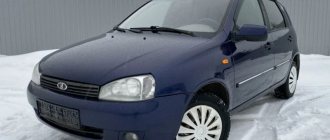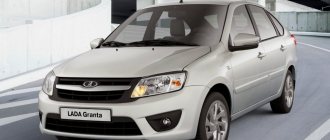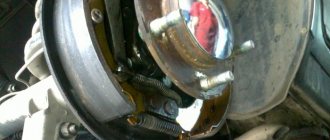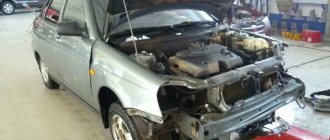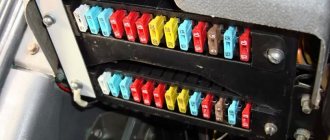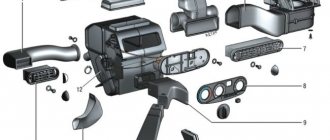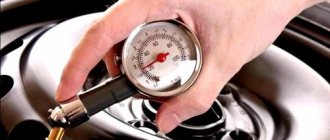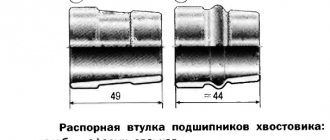For everyone who still doesn’t know what kind of engine the Chevrolet Niva has, this article has been prepared. Indeed, recently the Chevrolet Niva, whose engine capacity is 1.7 liters, has been quite popular in the CIS countries, so many are interested in the Chevrolet Niva engine and the possibility of tuning the Chevy Niva. We will now consider all these questions.
Body and external elements
The body is still quite reliable, with the exception of the wheel arches. If you do not treat them with protective agents in a timely manner and do not protect them with plastic fender liners, pockets of corrosion will appear on the arches very quickly.
It is noted that not enough paint is used to paint the plastic elements of the body, so the paint layer quickly begins to come off from the plastic elements.
At first it was indicated that this car received a nameplate on the radiator grille from Chevrolet.
But our specialists attached it, and they couldn’t come up with anything better than putting the badge on double-sided tape.
As a result, washing and the use of high-pressure washing units can easily knock off the nameplate. Therefore, owners often either wash the car themselves, or at the car wash they warn that high-pressure water should not be applied to the nameplate.
Many people note that the head light on the Chevrolet Niva is very decent, but even here it was not without troubles.
After washing or driving in the rain, condensation forms on the inside of the headlight lenses.
Regarding the headlights, the use of weak housings for the side lamps is also noted. As a result, the housings quickly melt.
After purchasing a car, it is better to immediately replace the standard lamps with LED ones to avoid this problem.
Niva with turbine
The most common way to add power to an engine is to install a turbine or compressor, which will significantly increase the volume of air entering the power plant.
Installing a turbine is not a complex tuning solution, since the turbine itself has a fairly simple structure. The supercharger and turbine impellers are mounted on the same shaft, and the exhaust gases are the drive. Thus, we can observe the most efficient use of energy from combustion products in a car. The absence of interaction between the crankshaft and the turbine shaft also increases the efficiency of the power plant.
In general, the Niva engine can and should be modified, and then your car will become more powerful and last much longer. This is what we should strive for!
Power point
Let's start with the “heart” of this car – the engine. It’s worth noting right away that the unit installed on this SUV does not pull at all, a car that is designed for off-road capability.
Power 80 l. With. at 1.7 liters the volume is not enough for this car; it is more suitable for a passenger car.
You shouldn't expect agility on the road from a Chevrolet Niva equipped with such an engine. Since this is, after all, an SUV, you don’t have to look at its speed indicators, and the figure stated in the documentation of 160 km/h is quite enough for it.
Using air conditioning while driving can further reduce the already “dull” performance. With the air conditioner running, the engine actually behaves like a “vegetable”.
The car strongly “resists” acceleration, so forget about overtaking and maneuvers that require sharp acceleration.
As for the technical performance of the power unit, it is not bad. The installation does not cause any major problems other than routine maintenance.
The only weak point in the engine is the crankshaft seals. On some cars they don’t even last 30 thousand km.
Permanent all-wheel drive on this car is good, but only for driving on country roads. In urban conditions, this advantage becomes a disadvantage - fuel consumption in the city of the Chevrolet Niva is high. The car consumes over 10 liters.
Using an air conditioner can significantly increase fuel consumption.
Now on to the power plant systems.
One of the most problematic in the Chevrolet Niva is the cooling system, or rather its components.
The expansion tank of the system is “flimsy” and cracks often appear on it, through which coolant leaks. Some owners change this tank almost every year.
The water pump can also cause problems. On some cars, the pump fails regularly, but such a nuisance does not happen on all Chevrolet Nivas.
The power supply system does not cause any complaints from owners; it is reliable when properly cared for. The only thing that can happen to it is the failure of the sensors (mass air flow sensor, mass air flow sensor, DPKV).
But problems with sensors are common to many cars, so it is wrong to consider them only the Chevrolet Niva’s weak point.
The exhaust gas removal system is also reliable, but there are some issues with it.
The catalyst of this system is located close to the bottom, which is why heat from the catalyst is constantly transferred to it. And if in winter this can even be considered an advantage - some kind of additional floor heating, but in summer there is no need for additional heat in the cabin.
Well, the catalyst itself is already a “headache” for the owner. A couple of refills with low-quality gasoline, and the device is due for replacement due to burnout or severe blockage of its cells.
And since the catalyst is an expensive element, this problem is also unpleasant from the financial side. An alternative solution is to cut out the catalyst and use a resonator instead.
There is nothing to say about the lubrication system; it copes with its duties well and does not cause problems.
But electrical equipment causes trouble. The weak point in this system is the generator. It fails quite often; on many cars it is replaced under warranty within the first year of operation.
Some owners, in order to avoid problems in the future, simply select and install a similar element from a foreign car instead of a standard generator.
Salon
There are also plenty of shortcomings and weak points in the cabin. First of all, the small volume of the luggage compartment is noted. But this drawback is conditional; for some, the volume is quite enough; additionally, the trunk can be increased by folding the rear seats.
The second weak point in the cabin is sound insulation, or rather its complete absence. When driving inside the car, you can hear everything - the engine, the transmission, and the chassis.
The tightness of the interior is not up to par. Drafts and odors make their way inside, even on the new Chevrolet Niva with seals that have not yet dried out.
The presence of air conditioning is a positive quality, but it greatly “eats” the performance of the power plant, so drivers have to decide whether to drive in comfort, but barely, or without comfort, but a little faster.
Window lifters are a convenient thing, but on the Chevrolet Niva the plastic drive gears of the mechanism quickly wear out. After only a short period of use of the car, you can lose this convenience.
As for the dashboard, everything is in order except for the fuel level sensor. On many cars, its readings are incorrect.
Naturally, the interior plastic leaves much to be desired, since it is hard and its fastening is weak. Therefore, even a new car is characterized by crickets, etc.
Chevrolet Niva electronics, in particular power relays, can cause additional problems.
These relays are responsible for the operation of the cooling system fans, fuel pump, electronic control unit and ignition.
Failure of any relay other than the fan relay can render the vehicle immobile. Therefore, it is better to always have a spare set of these relays with you.
Uaz patriot in the new generation - beautiful, but not functional
Patriot is one of the anticipated cars that was advertised for a long time before its release. The car has already changed generations and taken on a slightly different appearance. Having lost a large market share due to an objectively outdated and uninteresting design, the company decided to make a good update to the exterior as well as the interior. Today UAZ Patriot has the following important features and characteristics:
- choice between a good gasoline and a modern diesel engine with good performance;
- successful exterior, tailored to the requirements of a modern person in any driving situation;
- good technology, a good replacement for a manual transfer case with electronic all-wheel drive with good control;
- impressive cross-country ability, thanks to fairly powerful updated power units;
- quite nice appearance with modern updates, but keeping in the class of brutal cars.
A few comments
- Some deviation from the readings indicated in the table of factory values is allowed. For example, on a BMW 3, the thickness gauge showed 170 microns (and according to the standard it should be in the range of 100-165), but this does not mean that the component was repaired. Much depends on the year of manufacture, place of assembly, and whether polishing was done.
- Some motorists are frightened by some scatter of values during the measurement process. Here you need to take into account that such a spread occurs even on a car that has just left the showroom. If the fender shows 100, the hood 140, the door 120, then this is normal.
- Practice has proven that the thickness of the paintwork on domestic and Japanese cars, even according to the table, is a thin layer - about 100 microns. The European manufacturer paints with a thicker ball of paint - 150 microns.
- The internal elements of the body have a layer of 40-90 microns, because external influence on them is not provided.
- Minor dust or dirt on the surface does not particularly affect the final measurement result, but a crust of dirt will be a serious obstacle to obtaining correct results.
Chevrolet Niva
- Years of manufacture
— 2002–2020 - Restyling
— 2009 - Secondary prices
- from 200,000 to 500,000 rubles
Prices for Shniva start at about 150 thousand rubles. But it’s not worth buying a Tolyatti all-wheel drive for less than 250–300 thousand. Such specimens are usually rolled into steep hills. This model is chosen not by year of manufacture or mileage, but by condition.
Many sellers entice with rich tuning, but handicraft modifications often affect reliability. A suspension lift will “kill” the drives, and large wheels and self-blocks will “kill” the bearings, axle shafts, transmission, and clutch. This Tolyatti SUV was created on the components of a passenger car, so any modification must be adequate. So it’s better to look for “Nivka” in a variation as close as possible to the assembly line.
Available configurations and prices
The new, 2022 Chevrolet Niva is sold in 8 trim levels, including the maximum (710 tr.) and luxury (725 tr.). A wide choice, considering that until 2009 the Niva was produced in 3 trim levels, and until 2006 - in one. Prices for new cars are presented on the official website: from 553.5 tr.
The base includes: heated feet, electric windows and exterior mirrors, some modern security systems, 15-inch alloy wheels, isothermal glass.
The top versions are even different in appearance: the bumpers, arch trims, canopy over the spare wheel and door handles are body-colored, roof rails can support up to 75 kg, 16-inch wheels are installed, and the rear windows are tinted. The luxury version is not just a little better equipped and more comfortable, but is also designed to overcome more serious water obstacles (fords more than 40 cm deep).
Also, the Niva Chevrolet LE (630-660 TR) configurations are considered the most prepared for off-road conditions (fords up to 50 cm). Special versions are equipped with a snorkel to overcome water obstacles.
On the secondary market you can purchase any of the configurations up to 2019, including the Niva with a 1.8 liter engine and 122 hp, as well as the VAZ 2123, produced until 2002. Prices vary from 120 tr. up to 600 tr.
Answers (7)
If you don’t go off-road, then there’s simply no point in buying a Niva! and the rest of the Granta Priora Kalina are more comfortable, less power-hungry and less expensive city cars
really a good option, but it’s better to drive these cars to understand what suits you best
It’s better to take the Lada Kalina - a comfortable car, the Grant - worse, the Priora - the last century! VAZ Niva is a very uncomfortable car
Take Niva only if you are a jeeper, otherwise there is no point
I agree that you should buy a Niva if you like off-roading. Otherwise, it’s better to take Grant - a good car, more comfortable and better quality than the Niva. Niva should be taken as a second car in the family
You should take a Niva if you are interested in 4x4, are a fisherman or hunter, or live outside the city, but I agree, there is no point. I would take Kalina or Granta
Hello! As has already been correctly said here, it makes sense to take the Niva exclusively for off-road travel. In the city, such a car is not needed; driving on the highway is not comfortable, and in the absence of necessary skills, it is also somewhat dangerous, especially in winter. Therefore, it is better to stick to the front-wheel drive VAZ family, and it’s up to you to choose specifically based on the model. Take test drives, drive different models and different trim levels and find yours. Now, however, prices have changed and have gone over three hundred for the basic configurations of Grants, Kalinas and Prioras.
Chevrolet Niva is a wonderful SUV with universal functions
If you want to buy a car for traveling, not only off-road, but also on asphalt, it is best to choose a Chevrolet Niva. This car is equipped with a fairly modern design, as well as technology that makes driving on a normal road quite comfortable. Undoubtedly, in relation to all of the above, you can find a huge number of disadvantages, however, it is worth taking into account the cost of the car, as well as making a discount on domestic production. In this simple way, these same disadvantages can simply be written off.
Most Chevrolet Niva owners chose this car because they were pleasantly surprised by its appearance. Indeed, the interior of this car inspires confidence and amazes with its spaciousness literally at first sight. In this regard, only at the acquaintance stage the car leaves a good impression and invites further inspection, as well as purchase.
- The Chevrolet Niva engine was taken from the good old Niva and produces 1.7 liters, with 80 horsepower. However, some manipulations were made to it, as a result of which the engine became more modified;
- The engine loves to be revved up. This state of affairs was achieved due to good torque;
- Fuel consumption, in comparison with other SUVs, is quite high and reaches 14 liters during city driving. Nevertheless, the car feels quite confident in an urban environment;
- The Chevrolet Niva has such necessary SUV functions as permanent all-wheel drive, forced locking of the transfer case, and a locking differential;
- there is an independent suspension in front and a dependent suspension in the rear;
- When driving off-road, the car handles confidently.
All of the above features of the car make it comfortable for any ride. Therefore, if you need a car for driving not only off-road, but also for long trips on the highway, you can safely purchase a Chevrolet Niva. This car model has quite a wide range of capabilities for a comfortable, and most importantly, safe ride. True, the concept of “comfort” here is very relative, used only for comparison with other domestic SUVs.
Restyling 2009
After restyling, the Niva grew in size: its length was 4048 mm, it became 4056, its width became 1800 instead of 1770, and its height “rose” by 38 mm. And I gained 10 kg (1410). This is how the Chevrolet Niva appeared in a new body with a slightly “tweaked” exterior and many trim levels: different levels of equipment, comfort and external design. The designers replaced the bumpers (they got a rubber lining), mirrors, slightly modified the grille, installed new lens headlights, the lights got a rounded shape and a different pattern, and the rims got a different design.
In the interior, changes affected the shape of the steering wheel (it became three-spoke) and the handle (slightly enlarged, covered in leather). There are cup holders, a box for storing small items and an eyeglass case. The seats are upholstered in higher quality material. The door seals were made thicker (to increase sound insulation). A new audio system was also installed.
In 2010, engineers replaced the driveshaft crosspieces with CV joints and modernized the hinge joints in the front suspension.
Another small modernization was carried out in 2015. Engineers at the GM-AvtoVAZ plant worked on the engine. As a result of their efforts, fuel consumption decreased: on average 10.2 liters, in the city - 13.2, on the highway - 8.4 liters). And in order for the engine to comply with Euro-5 standards, the amount of emissions into the atmosphere was reduced. Now the car accelerates longer – in 19 seconds. The torque has changed slightly - 127.4 Nm at 4000 rpm.
Differences in the interior
The high ground clearance of the UAZ Patriot causes difficulties when landing. To get to the threshold, you need to overcome a half-meter height. Therefore, you first have to climb onto the step, and only then can you enter the cabin. But once inside the cabin, you can get a pleasant feeling by contemplating the surrounding space from a decent height.
The Patriot's interior is distinguished by its spaciousness; it can comfortably accommodate the driver and all passengers, regardless of their size. The production of complete seats is carried out by the Japanese company. They may well provide a comfortable fit for a comfortable trip.
The lower location of the Chevrolet Niva sills ensures comfortable entry into the car interior. However, there is significantly less space in the cabin. Here, rear seat passengers have to rest their knees on the front seats. But, if we evaluate it as a whole, then all the interior elements are made quite carefully, the seats have a comfortable fit.
Engine
The all-terrain vehicle is equipped with a 1.7 liter (80 hp) gasoline engine with a timing chain drive. The design of the standard timing belt tensioner is not reliable enough - it allows the chains to jump. After starting a cold engine, the hydraulic chain tensioner (HNC) often rattles until the engine warms up. The weak points of the tensioner are the unreliable design of the aluminum oil supply tube and check valve. Replacing the GNC may be necessary after 50,000 km. A good alternative to a standard tensioner can be an analogue that has a longer service life. The chain stretches after a mileage of more than 100,000 km.
Niva VAZ - 2123 1998 - 2002
If the engine immediately stalls after being parked for a long time, then most likely you will need to replace the throttle position sensor (TPS, 300 rubles). This can happen already with a mileage of just over 10 thousand km. Replacing high-voltage wires may be necessary when the mileage is more than 60 - 80 thousand km. At around 80-90 thousand km, valve burnout occurs. And the rear crankshaft oil seal begins to “snotty” after 100 thousand km. If, after a mileage of more than 100 - 120 thousand km, the traction is lost and the engine starts to stall, then the ignition module may have come to an end.
With the same mileage, a knocking sound from the hydraulic compensators may occur. This can lead to breaking of the thread for the hydraulic compensator, destruction of the ramp and burning of the valves, which in turn will reduce compression in the cylinders. To avoid illness, car service centers recommend keeping the oil level closer to the MAX mark. If the knocking does not stop, it is better to replace the hydraulic compensators.
With a mileage of more than 100 thousand km, some engines begin to consume more oil - about 200 - 300 g. per 1000 km. The norm established by the manufacturer is 500 g. per 1000 km. The root cause is “hardened” valve stem seals that require replacement. Perhaps after 120 - 140 thousand km the oil pump will need to be replaced.
The idle speed regulator (IAC, about 500 rubles) can fail at more than 130 - 150 thousand km. Floating idle speed will indicate the need to replace it. A mass air flow sensor (MAF) will cost more - about 2,000 rubles, but it usually lasts more than 100,000 km.
The cylinder head gasket burns out after a mileage of more than 150 thousand km. By this time, the starter also “fits”.
In general, there are almost no serious breakdowns. Throughout the “life” of the motor, its unstable operation, starts not on the first try, and tripping are often observed. As a rule, this is due to failures of the IAC, TPS and crankshaft position (DPKV) sensors, as well as a malfunction of the fuel pump itself or clogging of its receiving grid.
In search of “happiness” and reliability of the engine, some owners replace the standard cylinder head with a new INA. But reviews of the results of such a reshuffle are not clear-cut. Some people notice improvements, but the remaining changes in the operation of the engine do not see. Some also replace the standard camshaft 213 with 214, due to which there is more traction at the bottom and the idle speed is more stable.
Front panel of Chevrolet Niva 2002 - 2009.
Noise from a running fuel pump is a common occurrence. It can be heard even on completely new copies. With a mileage of more than 150-170 thousand km (6-8 years of operation), it would be a good idea to look under the bottom. In the place where the fuel pipes come out of the body and go around the side member, a lot of dirt accumulates under the metal casing. As a result, a corrosion center appears that destroys the integrity of the pipeline. The danger lies in the occurrence of gasoline leaks and the possibility of fire.
The engine cooling system is disappointing with frequent radiator leaks. The coolant reservoir often turns into a consumable, bursting at the seam after 30 - 40 thousand km, or even more often. With a mileage of more than 60-80 thousand km, the lower pipe going to the radiator requires tightening, which often breaks off. The location of the pipe and clamp cause difficulties during this procedure.
And with a mileage of just over 20,000 km, the thermal shield of the exhaust manifold may burn out (the mounting bracket is destroyed), which, when the engine is running, begins to make unpleasant sounds reminiscent of rattling. The oxygen sensor (lambda probe) lasts up to 80 - 100 thousand km. With a mileage of more than 100 thousand km, the catalyst will most likely need to be replaced.
According to owner reviews, the average fuel consumption is about 9 - 10 liters per 100 km, in the city it is about 13.5 - 14.5 liters.
Diagnostics of engine condition by the appearance of Chevrolet Niva spark plugs
Normal candle.
Brown or grayish-yellowish color and slight wear on the electrodes. Accurate thermal value for engine and operating conditions. Soot deposits. Dry soot deposits on the Niva Chevrolet spark plug indicate a rich air-fuel mixture or late ignition. Causes misfire, difficult engine starting and unstable engine operation. Check if the air filter is clogged and if the coolant and incoming air temperature sensors are working properly.
Oil deposits. Oily electrodes and spark plug insulator. The reason is oil getting into the combustion chamber. Oil enters the combustion chamber through valve guides or piston rings. Causes difficult starting, cylinder misfires and jerking of the running engine. The cylinder head and piston group of the engine need to be repaired. Replace the Niva Chevrolet spark plugs.
Overheat. The reasons may be: the type of spark plug does not match the one recommended for your car’s engine, early ignition, lean mixture, air leaks into the intake manifold. Check the coolant level and whether the radiator is clogged.
Early ignition Niva Chevrolet. Melted electrodes. The insulator is white, but may be contaminated due to missed sparks and deposits from the combustion chamber falling on it. May cause engine damage. It is necessary to check the correct type of spark plug, serviceability of the knock sensor, cleanliness of the injector nozzles and fuel filter, operation of the cooling and lubrication systems.
Glaze. The insulator is yellowish, covered with glaze. Indicates that the temperature in the combustion chamber suddenly rises during sudden acceleration of the vehicle. Normal deposits become conductive. Causes misfires at high speeds.
Bridge between spark plug electrodes. Deposits from the combustion chamber fall between the electrodes. “Heavy” deposits collect in the gap between the electrodes and form a bridge. The spark plug stops working and the cylinder stops working. Identify the faulty spark plug and remove deposits between the electrodes.
Ash deposits. Light brown deposits on Chevy Niva spark plugs, covering the central and side electrodes with a crust. Isolated from additives to oil or gasoline. A large number of them can lead to insulation of the spark plug electrodes, causing misfires and interruptions during acceleration.
Wear. Rounded electrodes with a small amount of deposits on the working ends. Normal color. Causes difficult starting in cold or wet weather and poor fuel economy. Replace the spark plugs with new ones of the same specifications.
Detonation. The insulator may be cracked or chipped. This may damage the piston. Make sure that the octane number of gasoline matches the required one. Check the serviceability of the Niva Chevrolet knock sensor.
Spotted deposits. After proper adjustment, carbon deposits deposited in the combustion chamber begin to burn out and, at high engine speeds, come off the piston and stick to the spark plug insulator, causing occasional misfires in its operation. Replace the spark plugs with new ones or clean the old ones.
Mechanical damage. Damage can be caused by foreign objects getting into the combustion chamber, and if you use a spark plug that is too long, its electrodes can catch on the piston. This causes spark plug destruction, cylinder shutdown and can damage the piston. Remove the foreign object from the cylinder and/or replace the spark plug.
Enough about the bad things the owners say
Despite all these shortcomings, the Chevrolet Niva is characterized by its owners mostly on the positive side. All these weak points for a real driver who is not afraid to delve into his car are not critical.
Of course, the same owners “scold” the Chevrolet Niva for a large number of shortcomings, but at the same time they try to eliminate them, as well as improve the car by going through and replacing the chassis, applying sound insulation, and eliminating all other shortcomings and weak points.
For all its weaknesses and shortcomings, the Chevrolet Niva is in demand, and for several reasons.
The first is the cost of the car.
It is difficult to find a quite good SUV for such a price, even if it is of domestic production, albeit with an American name.
The second is cross-country ability.
The Chevrolet Niva drives off-road, and drives well. It will not overcome severe off-road conditions, but it will easily overcome moderate ones.
This car is perfect for lovers of outdoor activities outside the city, fishermen, and dacha owners.
It is worth noting that not every foreign crossover is capable of overcoming the off-road conditions that the Chevrolet Niva can overcome. And this despite the frankly weak power plant.
Third, high maintainability.
Most faults, due to the simplicity of the design, are eliminated in garages using improvised means.
Many people even like that this SUV, like most domestic cars, can be repaired “in the field, on your knees” without using any special tools.
Fourth is the availability of spare parts.
You can find spare parts and consumables for the Chevrolet Niva almost everywhere. At the same time, their cost is not as high as for foreign cars.
Necessary improvements
SUV owners usually prepare their vehicle for off-road use. The Chevrolet Niva in question was no exception. Stas told us what he changed in the car so that the Chevrolet Niva could use its full potential:
- Reinforced cardan shafts and reinforced axle thrust rods were installed;
- A 5-inch body lift was performed using non-standard springs;
- 29" wheels for dirt are installed. The turning radius of the car has increased, making it harder for the engine to turn the wheels. It is necessary to install a 4.3 main pair instead of the standard 3.9 - this will compensate for the load on the engine due to the large wheels;
- Installed HBO to save fuel. Gas consumption is approximately 13 liters per hundred. Gasoline is consumed the same way. But gas costs about 22 rubles, and gasoline - 40 rubles per liter of 1992;
- An expeditionary trunk, or rather a platform, was installed. The spare tire has been moved to the top. When the spare tire is installed normally, the door hinges quickly sag. Some people make a special “gate” for the spare tire.
Like any other car, the Shniva has weaknesses. We'll talk about them further.
Pros and cons of the Chevrolet Niva compared to a regular Niva
Let us highlight the characteristic features relating to both the 21st Niva and subsequent models VAZ-21213 and VAZ-21214. We will not consider the Long Niva (VAZ-2131), pickup truck (VAZ-2329) and other modifications. So, let's start with the undeniable advantages of the regular Niva compared to the Shevik:
- Patency. Due to the short wheelbase, the 21st model has better geometric cross-country ability.
- Price. In the same condition, a regular Niva will be 1.5-2 times cheaper than a Shevik.
- Availability and low cost of spare parts. Especially for body parts.
- "Psychological passability." An ordinary Niva is not so scary to be scratched or slightly dented, unlike a Chevrolet.
- The best predisposition for off-road tuning.
Now let's list the disadvantages of the 21st Niva compared to the Chevrolet Niva:
- Low level of comfort. Noise, vibration, lack of power steering (on old Nivas), uncomfortable driving position.
- Outdated design. Although this is a controversial point, because the design of an ordinary Niva is recognizable all over the world, which cannot be said about the Shniva.
- Poor aerodynamics.
- Poor handling on the highway.
- Cramped interior. This includes an uncomfortable seating position in the back row and a small trunk.
Everything is clear with the advantages and disadvantages of the regular Niva compared to the Shevik. Let's move on to the Chevrolet Niva.
Let us list the main advantages of the Chevrolet Niva:
- Modern and quite successful design.
- Passive safety. Although its level is unacceptably low, it is still slightly higher than that of a regular Niva. Chevy cars of recent years are preferable in terms of safety.
- Relatively high level of driving comfort. Less vibration, less noise, comfortable driving position, power steering.
- Spacious salon. This also includes a comfortable back row, seating and a relatively spacious trunk.
- Not bad aerodynamics.
Now the disadvantages:
- More expensive than a regular Niva, both in purchase and in maintenance and repair.
- Poor cross-country ability due to the extended base and lower bumpers.
- An abundance of plastic, especially on new Sheviks. A controversial point, because plastic protects the body from minor damage (scratches, chips).
- Weak engine. The dynamics of Shevik are worse than those of a regular Niva.
- More mass. On marshy soils this is a minus, but in other cases it can be a plus (shallow mud, loose snow).
Plastic protects the body from scratches and chips
It is also worth paying attention to one more point - body rigidity. It seems that the three-door car should have it higher, but the Shevik has thicker side members, so not everything is so simple
Main competitors
In its niche and price segment, the Chevrolet Niva is the undisputed leader. When choosing a car that costs 400-800 rubles, car enthusiasts consider, in addition to the Niva, only the Lada and Renault Duster, and sometimes the Japanese Suzuki Grand Vitara. They also look at Chinese and Korean SUVs, but much less often: Ssang Yong Actyon, Chery Tiggo, Great wall H3.
If you choose between Niva Lada or Niva Chevrolet. The choice will fall on the first model only if there are insufficient financial resources. Since the Chevrolet looks more modern and is more comfortable inside, its trim levels have more options, especially in the restyled version.
If you choose between a Chevrolet Niva or Renault Duster, then you should choose the latter if you are not a hunter or fisherman and do not travel through impassable places, and if the level of comfort is more important than the level of cross-country ability.
If you still decide to buy a Chevrolet Niva
First of all, think hard about whether you really need it. And it's not a joke. Chevrolet Shniva is, first of all, the same Niva. The entire internal filling is almost completely identical to the good old Niva, now Lada 4x4. A more comfortable interior and the presence of air conditioning (although Lada 4×4 now has it) do not make this car a Chevrolet. This car has all the same problems and problems as the regular Niva, the most common ones I will name below.
When a Chevrolet Niva is bought by a person who has previously dealt with a simple Niva (like me), he most likely understands what kind of car it is and what it comes with. But when it is bought as a first car or as a replacement for a completely different one, there are not always surprises, as evidenced by the numerous questions from novice shniva drivers on thematic forums. Below I will list some popular complaints based on these issues.
She's not coming
What do you want? The car weighs almost one and a half tons, and the engine is only 79 hp. Yes, you really have to put up with this, since, despite numerous requests, the same engine is provided for all trim levels, there is absolutely no choice. If you are a calm person and don’t like driving fast, you can most likely survive this.
When changing gears I hear some knocks and feel jerking, is it broken?
No, this is the norm. This is how the total play of the transmission manifests itself, which is present even in a new car, despite the more modern CV joint cardans that have been equipped with manufactured cars in recent years. The solution is simple - get used to working the clutch carefully. First select the play and only then release the pedal completely.
Gears are difficult to engage, especially 1st, 2nd and reverse
If there is a Shniva whose gears turn on like clockwork, I will be very surprised. It is about 1, 2 and the back that many people complain. Moreover, this also applies to new cars. There are two ways out. The first is to go through a run-in (I’ll tell you about it a little further), perhaps after that something will change. The second - if after the break-in nothing has changed, and the dealer says that the case is not under warranty and in general everything is fine - come to terms with it and, horror of horrors, in the 21st century, master throttling and double squeezing. We won’t talk about this here, but you can search on your own, there is plenty of information on this topic.
As for the reverse gear, if after stopping it is difficult to engage or a crunching sound is heard when engaging, then engage it through 1. That is, first 1, and then immediately R. If 1 is difficult to engage on the spot, then you can try to engage it, for example, through 3. In the case of such problems with a new car, I recommend that you first pester the dealer about the warranty; nevertheless, this should not happen in a new car, but, judging by the complaints, it happens on every corner and my car is no exception.
I decided to try the center differential lock and now it won’t turn off.
This problem occurs in new cars or in cars that have already been used, but where the lock was used extremely rarely. In this case, I recommend finding the nearest place with a slight slope, starting to roll down it at a very low speed, the gearshift lever should be in neutral at this moment. While moving, press the locking lever away from you, this should help.
You feel a strong vibration in the steering wheel, as if something is loose
The most likely options: crooked tires, crooked wheels, play in wheel bearings. If the first two reasons are not critical and only affect the comfort of control, then the play of the hubs is fraught with a sudden breakdown and an accident if at the wrong moment the hub jams due to a collapsed bearing. I will try to write a separate article about adjusting wheel bearings, and maybe make a video, although there is a lot of information about this on thematic resources
But here I want to draw your attention to this. The age of the car is not important; cars with this problem often leave the showroom and the happy owner doesn’t even know about it
Weaknesses and malfunctions of the Chevrolet Niva
On the Internet you can find many “terrible” descriptions of problems and breakdowns of the Chevrolet Niva. For example, that already at 50,000 km, problems with the timing chain may begin, the starter may fail, the clutch will burn out, the transfer case will “snot”, through metal corrosion will begin, and so on. But in practice, as we see, you can find a huge number of Shnivas on the roads and in pretty good condition, and there is also considerable demand for the car aftermarket. And would people buy a “bucket of bolts” that needs to be constantly repaired and invest their hard-earned money into it? I think no. The Chevy Niva is actually a good SUV, and many problems about it are simply made up and exaggerated many times over.
Here I will describe what you should check before purchasing, what you should pay attention to, and what problems may arise. After all, you see, the same car can be in completely different states, depending on its owner and operating conditions.
And also interesting: What kind of oil to pour into the transmission, transfer case and axles of Niva Chevrolet || Oil for taiga fields
1) Corrosion. This is a really common disease of Shniv bodies, since only a part of the parts were galvanized at the factory, and even then of poor quality. Rust, even in 5-6 year old cars, can be found in the area of chips - hood, fenders, side members. And the most problematic places remain the rear wings and arches.
Therefore, it is recommended to carry out additional anti-corrosion treatment for this vehicle. And it’s very cool if you come across such a copy, the previous owner of which has already treated the body with anticorrosive and installed fender liners.
2) Timing chain. On the Internet you can find stories where the chain jumped already at 60-80 thousand kilometers and had to be changed. In practice, this disease does not occur on every car, but this cannot be denied. Therefore, it is necessary to periodically monitor the condition of the chain, and usually replacing the chain tensioner and pump solves this problem.
For example, a friend’s Chevy Niva already has 110,000 km on it, and he hasn’t done anything to the chain. Everything works fine. But he says that with a mileage of about 150,000 km it will be necessary to change the chain, tensioner, and pump. And also change the hydraulic compensators.
When inspecting, listen to see if there are any extraneous noises in the engine operation.
3) Brake pads fail quite quickly. But this is a consumable material, especially since it is worth considering that this car is usually often used in off-road conditions - sand, water, all this quickly corrodes the pads.
4) When inspecting, check to see if the axle gearbox and transfer case are leaking. There is such a disease on Shnivy, but this nuance, again, does not occur on every car and may not appear until 150,000 km.
And it is also important that the transfer case and transfer case do not make too much noise when driving, otherwise you may end up having to completely replace these components. Or it will be enough to replace the clutch or the release bearing itself. A little noise is quite acceptable, because they cannot work absolutely without noise.
5) The factory 80-amp generator KZATE-80A lasts quite a long time, although some write that it fails even before 100,000 km. Some people change it to a more powerful one, for example, the 100-120 ampere KZATE-120A. But you shouldn’t touch it if there are no problems. In addition, you can go to an auto electrician and resolve the issue without a complete replacement.
6) As for shock absorber bushings, hubs, oil seals, silent blocks, bearings, their serviceability will depend on how and where the owner drove. If you didn’t skimp on the off-road, jumped on the pits, then of course the parts will wear out quickly, and if you moved at a moderate pace and treated them with care, then they will last about 80-100 or more thousand kilometers.
Ball joints have to be changed every 35-40 thousand km.
7) Expansion tanks on Nivas have a short lifespan, and in 80-100 thousand km you can change them three times.
 The starter usually dies after 90,000 km, some earlier, some later. The cost of a good starter is 2500-3000 rubles.
The starter usually dies after 90,000 km, some earlier, some later. The cost of a good starter is 2500-3000 rubles.
9) The interior, naturally, does not feature super-high-quality finishing materials, and there is plenty of noise in it, but for the money it is quite tolerable. The weak point is the steering wheel upholstery, which peels off after 30,000 km. The solution is to install an overlay.
To summarize, I will say what is obvious to me. Chevy Niva is a decent SUV, more comfortable and roomy compared to the VAZ Niva. However, when buying it, you should understand that you will have to invest, but how much depends on the specific option. I meant a used car. I'm not saying anything about the new one. So when buying, inspect everything thoroughly, go to the service center, go to the lift, listen to the internal combustion engine, gearbox, manual transmission and everything else.
Corrosion - 2003 model. Usually, when a car has fender flaps, it is a sign that they are hiding rust.
Valve train chain
Chevrolet Niva transfer case leaking
The tank burst - usually due to temperature changes
covered the steering wheel
Rust on the body
We probably won’t discover “America,” but the fact, as they say, is obvious. Alas, as the owners write on the forums, the paintwork still leaves much to be desired. Varnish and paint gradually give way under the pressure of weather conditions, “salty” winters, and the scorching sun. The result is microcracks, the air begins to oxidize the metal, and unpleasant brown areas of corrosion appear.
But this is not so bad, the worse thing is that under the pressure of weather conditions and reagents in large cities, anti-corrosion protection gives weakness. This is where the most unpleasant things begin - rot spreads in closed cavities, under the bottom and in other hard-to-reach places.
According to users, rust may appear in the third or fourth year of operation.
In this regard, we advise you to update the anti-crust layer once a year by pouring the composition into the closed cavities of the underbody.
Here are the problems you will encounter if you take a Chevrolet Niva: Top 6
Chevrolet Niva began production 17 years ago, in 2002. The model has come all this long way without even changing the first generation. Restyling, however, did not bypass it in 2009, but you definitely won’t find any great differences in the two versions of the same compact SUV. By the way, the update was implemented by the well-known car studio Bertone.
Nevertheless, the car remains in demand among compatriots due to its affordability and good consumer performance. With a cost of less than 700 thousand rubles and a “ceiling” of 810,000 rubles at the moment, as well as a 4x4 wheel arrangement with very reasonable all-terrain properties, it is difficult to find a better budget compact SUV. And, unlike the same UAZ Patriot, the Cehvy-Niva is comfortable both in the city and on the highway on the way to the dacha.
Yes, there are drum brakes at the rear, yes, the “maximum speed” is 140 km/h, and the consumption in the city is about 14 liters of AI-95 from a modest 1.7-liter engine (80 hp, 127.5 Nm of torque), and this is with standard driving mode on an undamaged engine. Yes, the interior is old... and there are many other “buts” in this car. But it’s cheap, accessible, and easy to repair.
The buyer still votes with rubles for the old man. This can be seen even in model sales in April 2022. The SUV is included in the Top 25 best-selling cars with the number of SUVs sold in the amount of 1,853 units.
Moreover, it didn’t work out with the new product, but that’s a separate conversation.
Installing a turbine on a Chevrolet Niva engine
This type of Chevrolet Niva engine tuning will easily increase engine power by 30%! The price of a turbine for a Chevrolet Niva is about 67,000 rubles, including installation.
Installing a turbocharger allows you to increase engine torque at low and medium speeds. The turbine allows you to increase power, torque and makes the engine more economical.
Basically, the GARRETT GT17 turbocharger is excellent for Shniva, the characteristics of which meet all the requirements. After installing this turbocharger, the torque characteristics of the engine were significantly improved (an increase of 35% was found in the area of low crankshaft speeds).
Shniva engine with turbine on bench tests showed:
- increase in engine power to 105 hp (factory engine – 80 hp);
- increase from 120 to 170 Nm of torque.
Thus, the improved power unit of the Chevrolet Niva allows it to accelerate from 0 to 100 km/h 5-6 seconds faster. Other features of the powerful engine have become available: you can install larger diameter wheels, drive off-road in fifth gear, and much more. The fuel can be used as before - 95 gasoline.
So, there are several worthwhile options for tuning the Chevy Niva engine, the main thing is to choose the best one for yourself in terms of monetary costs and in terms of installation complexity.
And then a video about modifications to the Chevrolet Niva engine:
Share on social networks
Alex S February 15, 2020
Published in: Useful tips and car devices, Russian cars
Tags: Chevrolet, SUVs, Jeeps, Tips for motorists, Tuning, SUV tuning
Read news about the new Niva
- Chevrolet Niva engines: characteristics and capabilities
- Oxygen sensor NIVA (Euro-2) Bosch 0 258 005 133 (lambda probe) 2112-3850010-20 (until spring 2006) 2180 - Exhaust system - Shop of auto parts and accessories for Niva and NIVA-Chevrolet cars
- Types of hubs: automatic and mechanical. — Bezdor4x4-Blog
- How to properly use the transfer case on Niva 2121
- The principle of operation of the Niva Chevrolet car air conditioner
- All-wheel drive connection system | Toyota | Toyota Management
- SUV rating: Off-road drive
- Camshafts VAZ 21213 with bed in Balashikha


